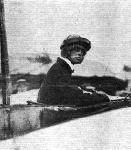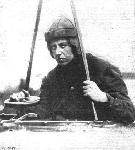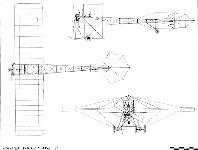
Описание
Страна: Великобритания
Год: 1910
S.Ransom, R.Fairclough English Electric Aircraft and their Predecessors (Putnam)
Scottish Aeroplane Syndicate Avis
The Avis Monoplanes were designed by W.O. Manning and built by Howard T. Wright for the Scottish Aeroplane Syndicate of 166 Piccadilly, London, W. Known, as the Golden Plover, the prototype, which was fitted with a 3O hp Anzani engine, was completed at Battersea in December 1909, and delivered to Brooklands for testing. In January 1910, the Hon Alan R. Boyle, who had founded the Syndicate made the initial trials. These did not prove entirely satisfactory and the aircraft was brought back to Battersea to be re-engined with a 35 hp Anzani. A tail unit of decreased area was also fitted. The aircraft, renamed Avis, returned to Brooklands, where Boyle achieved his first straight flights with it in March and April, and his first circular flight in the following month. A little later, he flew the Avis at the 1910 Wolverhampton aviation meeting to win first prize for endurance in the monoplane class with a time in the air of 7 min 53 sec. Early in June, Boyle took delivery of a second aircraft of the type to which he allotted his personal coding, No. 3 being painted on the rudder. Apparently, Boyle regarded his previous machine as having two separate identities. The official nomenclature of Boyle's 'third' aircraft was Avis I and it was fitted with a 40 hp ENV engine. At Brooklands on 14 June, he used his new machine to gain Royal Aero Club Aviator's Certificate No. 13. Almost one month later, at the Bournemouth aviation meeting, Boyle was severely concussed when he crashed in Avis I. In the meantime the prototype Avis had been sold to Maconie. (Unfortunately nothing has been found to identify Mr Maconie or even confirmation of the spelling of his name. There was a statement in The Aero dated 10 August, 1910, which read 'Mr Maconie has put in several days practice on his Avis monoplane, and is rapidly gaining control of the machine.')
Meanwhile, the 40 hp JAP-engined Avis II had been exhibited at the 1910 Olympia Aero Show on the stand of the Aeroplane Supply Co, which acted as selling agents for the Syndicate. After the show it was bought by R.F. Wickham, who had the misfortune, whilst flying it, to experience an engine failure over the sewage farm at Brooklands. Wickham managed to land the aircraft but in doing so struck a raised cement canal crossing the farm. Damage to the machine was extensive. Avis III, also fitted with a 40 hp JAP engine, was purchased by J. Herbert Spottiswode, a well-known racing driver at Brooklands. On 5 October, 1910, Spottiswode piloted Avis III to fifth place in a competition sponsored by the Brooklands Automobile Racing Club, which offered monetary prizes for the greatest aggregate times in the air. N.C. Neill, offered a gold cup, also, to the pilot who flew the longest distance. The event was won outright by Graham Gilmour flying Big Bat with a total time of 2 hr 59 min 16 sec, Spottiswode's aggregate was less than five minutes. Avis III was later purchased by Campbell-Gray, a photographer of 88 Edgware Road, London, who used it for humorous publicity. On recovering from his accident, Boyle returned to flying at Brooklands with the purchase of Avis IV. With the collapse of the Syndicate, however, this aircraft became the subject of the country's first recorded aeronautical auction, held in December 1910, when it was sold, complete with JAP engine, to Eustace Gray, Brooklands' press steward, for ?50.
In appearance the Avis closely resembled many other single-seat monoplanes of the period but the type could be distinguished by its universally-mounted Demoiselle-style tail unit. The fuselage, made of ash, was of conventional wire-braced box-girder construction. The aircraft was controlled by warping the parallel-chord wings from foot pedals, and by the cruciform tail from a control column pivoted at its lower end, the elevator being operated by fore and aft movement of the column and the rudder by turning the wheel attached at the column's upper end. The twin-skid undercarriage was of sturdy construction and each item of it could be replaced without it being totally dismantled. Two pairs of wheels were attached across the skids by rubber cord shock-absorbers and the support for the small tailwheel incorporated a helical spring. The prototype aircraft was fitted with a Chauviere propeller but one made by Howard Wright from a single piece of Kauri pine was fitted together with the more powerful Anzani. All subsequent versions of the Avis had Wright-built propellers.
In flight the Avis was easily controlled and because it had been designed with its centre of gravity well forward, so that there was little or no load on the tail, the take-off was lively, the slipstream from the propeller immediately lifting the tail on starting the engine.
The design was developed further as the 1910 Monoplane.
Avis (as general arrangement)
Span 27 ft; length 27 ft; height 9 ft 2 in; wing chord 6 ft 4 in; wing dihedral 5°; wing incidence 9°; propeller diameter 6 ft 3 in; main undercarriage track 4 ft 6 m; wing area 170.4 sq ft; elevator area 22 sq ft; rudder area 14 sq ft.
Weight without engine 280 lb; weight empty 430 lb; weight loaded 630 lb.
Cruising speed 35 mph; maximum speed 40 mph.
Price ?370-?490.
Описание:
- S.Ransom, R.Fairclough English Electric Aircraft and their Predecessors (Putnam)
- M.Goodall, A.Tagg British Aircraft before the Great War (Schiffer)
- P.Lewis British Aircraft 1809-1914 (Putnam)
- Журнал Flight
Фотографии
-
S.Ransom, R.Fairclough - English Electric Aircraft and their Predecessors /Putnam/
The Hon Alan Boyle's Anzani-powered Avis at Brooklands early in 1910. The authors believe that Boyle regarded this aircraft as his second machine because it had been re-engined with a slightly more powerful Anzani and the tail surfaces had been reduced in area. The photograph suggests that the machine was about to be named Avis, it having previously been known as the Golden Plover.
-
Журнал - Flight за 1910 г.
AVIS MONOPLANE. - View from behind.
-
P.Lewis - British Aircraft 1809-1914 /Putnam/
AVIS MONOPLANE. - View from in front.
-
Журнал - Flight за 1910 г.
The Hon. Alan Boyle flying at Brooklands on his Bleriot monoplane. On Wednesday Mr. Boyle was out for sport, and made an excellent flight at a height of about 70 feet.
-
Журнал - Flight за 1910 г.
The Hon. Alan Boyle was last week seen in a photograph, published on page 306, flying on the "Avis" monoplane - obviously not a Bleriot, as appeared by a slip in the inscription. Above we are now able to give two much clearer pictures of this successful British-built machine in full flight at Brooklands under the direction of Mr. Boyle, The builders of the "Avis" are the Scottish Aeroplane Syndicate, of 166, Piccadilly.
-
Журнал - Flight за 1910 г.
Flying at Brookiands on Wednesday of last week when at one time there were no less than six machines in the air together. - Our photograph shows in full flight the Hon. Alan Boyle on his Avis monoplane (on the left) and Mr. Claude Grahame-White, with a passenger, on his Henry Farman biplane.
Другие самолёты на фотографии: Farman Farman-IV - Франция - 1910
-
S.Ransom, R.Fairclough - English Electric Aircraft and their Predecessors /Putnam/
J. Herbert Spottiswode flying Avis III at Brooklands.
-
P.Lewis - British Aircraft 1809-1914 /Putnam/
Hon. A. R. Boyle's Howard Wright Avis at the 1910 Bournemouth Meeting.
-
Журнал - Flight за 1910 г.
IN FRONT OF THE BOURNEMOUTH AEROPLANE SHEDS. - The Humber and Avis monoplanes are standing in the foreground,
Другие самолёты на фотографии: Humber Bleriot type monoplane - Великобритания - 1910
-
S.Ransom, R.Fairclough - English Electric Aircraft and their Predecessors /Putnam/
Howard Wright's workshop at Battersea in January 1910. In the foreground is Boyle's Anzani-powered Avis and on the right Lascelles' Ornis under construction
Другие самолёты на фотографии: Howard Wright Ornis - Великобритания - 1909
-
S.Ransom, R.Fairclough - English Electric Aircraft and their Predecessors /Putnam/
The Hon Alan R. Boyle at the controls of the Avis.
-
Журнал - Flight за 1910 г.
THE FLYING MEN AT BOURNEMOUTH AND THEIR "MOUNTS." - Hon. Alan Boyle (Avis).
-
Журнал - Flight за 1910 г.
Mr. Wickham, who is flying the Channel in connection with the De Forest L4,000 prize, at the wheel of his Avis monoplane.
-
Журнал - Flight за 1910 г.
WING SECTIONS. - The above diagrams afford an interesting comparison of the wing sections of aeroplanes exhibited at Olympia. They are all drawn to a common scale, but have been set at an arbitrary angle of incidence, which does not necessarily represent that of the aeroplane In actual flight.
Другие самолёты на фотографии: Avro Triplane I / II - Великобритания - 1909Bleriot Bleriot-XI - Франция - 1909Farman Farman-III - Франция - 1909George & Jobling biplane - Великобритания - 1910Gregoire-Gyp Type 1910 - Франция - 1910Handley Page Type A (C) / H.P.1 (H.P.3) - Великобритания - 1910Howard Wright E.N.V. monoplane - Великобритания - 1910Howard Wright Ornis - Великобритания - 1909Humber biplane - Великобритания - 1910Humber Le Blon type monoplane - Великобритания - 1910Humber Lovelace type monoplane - Великобритания - 1910Lane monoplane - Великобритания - 1910Nicholson monoplane - Великобритания - 1910Petre monoplane - Великобритания - 1910Santos-Dumont Demoiselle - Франция - 1907Short Biplane No.2 / No.3 - Великобритания - 1909Sommer Sommer-1 - Франция - 1910Spencer-Stirling monoplane - Великобритания - 1910Star monoplane - Великобритания - 1910Twining biplane - Великобритания - 1910Wright Wright III / Wright A - США - 1905Zodiac No. 3 biplane - Франция - 1911
-
S.Ransom, R.Fairclough - English Electric Aircraft and their Predecessors /Putnam/
Scottish Aeroplane Syndicate Avis.
-
P.Lewis - British Aircraft 1809-1914 /Putnam/
Howard Wright Avis 3
-
Журнал - Flight за 1910 г.
Avis Monoplane. - Plan, side and front elevation.


















